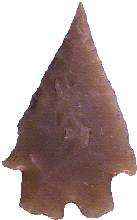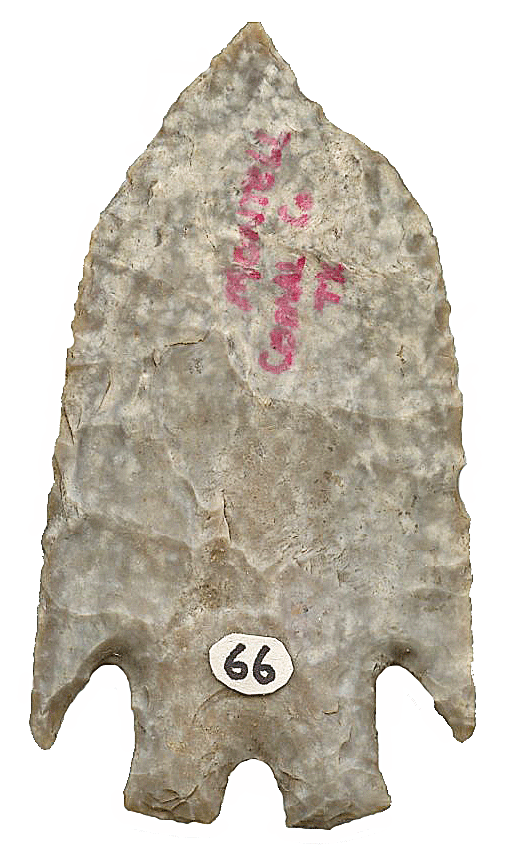



Point Type: MONTELL
Also See: Arredondo, Buzzard Roost
Creek, Kanawha, La Jita, LeCroy, MacCorkle, Pedernales, Uvalde
Location: Midwestern United States, especially Texas
Associated Dates:
5000 - 1000 B.P. - Late Archaic to Woodland
Morphology: Bifurcated
General Description: The Montell is a medium to large sized, thin, bifurcated base point with barbed shoulders that are acute to inversely tapered. Highly reworked specimens can exhibit weak shoulder barbs. The basal ears or lobes are usually squared. The stem is slightly expanding and has a median notch in the basal edge which is often narrow and never as long as the side notches. The blade is generally triangular in outline having edges which are mildly excurvate to straight. Some examples have rapier-like incurvate blade edges. On some specimens, the blades are unifacially beveled and are serrated. On some specimens the flake scars are large and random however workmanship is usually very fine.
The Montell is primarily a central Texas point which occurs westward to the lower Pecos area and the Big Bend area of the Rio Grande River. It is rarely found in Oklahoma. It is considered a diagnostic type of the Uvalde focus. Montell points can resemble the La Jita point in size and thinness and in overall general configuration and has a stem of similar size. The La Jita is different in that it has rounded basal corners and a straight to slightly indented basal edge which is not notched like the Montell. The Montell is also similar to the Pedernales, however the Pedernales does not have the Montell's squared basal corner edge look but has rather pointed to rounded basal edges. Additionally the Pedernales is generally thicker than the Montell.
The Montell can range from 38 mm to 110 mm in length based on a small sample size number of specimens. The width can range from 30 mm to 60 mm. The stem width ranges from 20 mm to 30 mm. The stem length ranges from 10 mm to 16 mm. The point was named the "Montell Split Stem" by J. C. Kelley in 1947 and the name was shortened to "Montell" in 1954 by Dee Ann Suhm, Alex. D. Krieger and Edward B. Jelks. It has historically been called the "Delia Notched Base Point" by F. Bryan in 1936 for examples he found near Delia, Limestone County, Texas.
About the Point Above (Left): The small Montell blade pictured at the top left of this page was found around the Fire Creek area of Gillespie County, Texas and was once in the collection of Pat Dunnegan. The point is made from a glossy light khaki colored brown flint which is translucent due to the blade's overall thinness. The edges of the blade show fine bifacial retouch and the distal end has been reworked into a nasty incurvate rapier tip. This blade exhibits strong shoulders which are barbless due to rework or historic mishap. The lower or left hand blade edge has a historic impact nick just above the barb. The blade in quite impressive in its thinness, workmanship and sharpness. Overall, the point measures 56 mm in length, is 42 mm wide across the shoulders, and is only 4.5 mm thick in mid blade with the majority of the blade being only 3 mm thick and translucent. The stem is 11 mm long and mildly expands to 23 mm wide. The stem thickness is 2 mm. The basal edge shows no grinding nor do the stem edges. Catalog Number 36-35-U
About the Point Above (Right): The Montell blade pictured at the top right of this page was found near the Guadalupe River, Comal County, Texas and was once in the collection of John R. Adams. The point is made from a semi glossy grayish tan and white mottled flint. The point is covered with small round callche deposits. The edges of the blade show fine bifacial retouch and the distal end has been reworked into trucated pentagonal shape perhaps due to a historic point fracture. One can only imagine what this point looked like prior to the blade tip fracture! I would estimate its original length to have been in the 90 mm range. This blade exhibits strong shoulders which have intact, inversly tapered drooping barbs. This blade, like the one above is quite impressive in its thinness, workmanship and retained sharpness. Overall, the point measures 68 mm in length, is 38 mm wide across the barbs, and is only 6 mm thick in mid blade (at the shoulders) with the majority of the blade being only 3.5 mm thick. The stem is 14 mm long and mildly expands to 23 mm wide. The stem thickness is 4 mm. The basal edge shows very mild grinding as do the stem edges. Catalog Number 66-70-O
References: Bell (1), Davis, Overstreet, Perino (1), Turner & Hester
© Copyright 1997 - 2008 LITHICS-Net WWW.LITHICSNET.COM
Use your Browser's BACK Button to return to the LITHICS-Net Index.